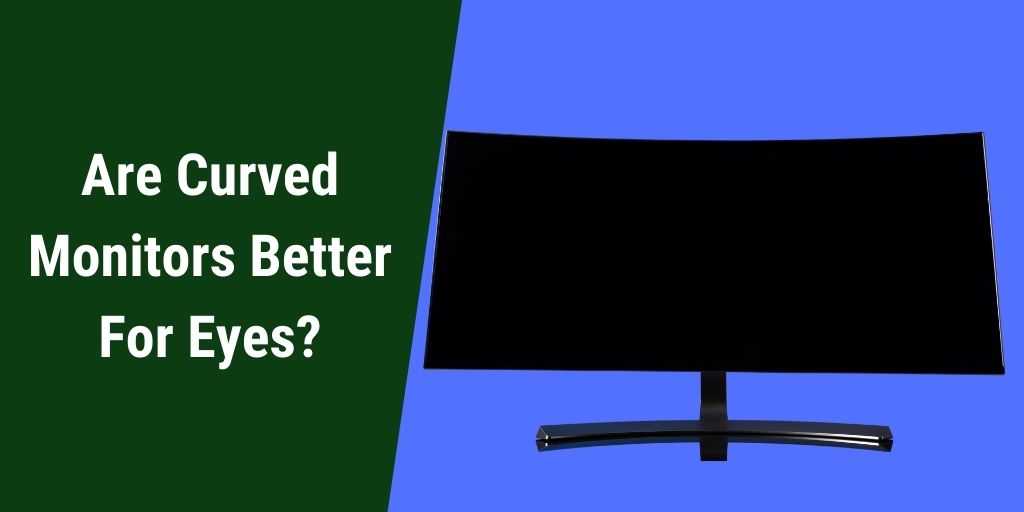Are you tired of eye strain and headaches due to long working hours in front of a screen? Does the display content become hazy and distorted after a certain time? Apart from these temporary issues, staring at a screen for long periods can be harmful to one’s health, producing neuromuscular disorders.
This is what brings us to the question, “Are curved monitors better for your eyes or not”? You are at the right place to efficiently resolve your matter by understanding how a curved screen Is better for you than traditional screens. It might be very helpful, comfortable, and better for your eyes.
Curved Monitors
The curved monitors allow us to take in everything simultaneously without straining our eyes. The distinctive shape is the consequence of a non-distort image structure. You’ll notice that the screen in a movie theatre is curved rather than flat when you go in. Even though people have different viewpoints, they all have an equally immersive viewing experience. Because it’s the only panel that can keep the pixels aligned in a curved frame, all curved monitors are VA.
It is because the human eye’s perspective is not flat. The viewpoint has a curved shape to it. Hence, a curved screen complements the natural shape of the human eye, resulting in a more natural display. So, if you’re wondering whether curved monitors are good for watching movies or not? Yes! Because they show a more lifelike experience.
You may also like this: Are curved monitors good for CAD?
Are Curved Monitors Better For Your Eyes Than A Flat One?
Yes! Curved monitors reduce eye strain because curved monitors distort images and reduce eye fatigue by providing less distortion, a larger field of view, and better viewing angles. Bottom Line: If staring at a computer all day bothers your eyes, consider getting a curved display that lets you see the full screen without straining your eyes.
This settles it then; curved monitors take the lead when it comes to curved monitor vs flat eye strain. Besides being a healthy addition to your routine, curved screens also boost your productivity by increasing your peripheral vision and reducing distractions.
Curved vs Flat Monitor/Gaming
Gaming is a high-intensity visual activity that challenges your eyes to keep up with fast-paced movements. Don’t you think curved monitors are better for gaming? Simply put, flat displays project images straight at the viewers and past their sides. On the other hand, curved screens use their curve to direct everything toward the viewer, reducing distortion.
The width of flat screens typically ranges from 23 to 27 inches (though you can still find plenty ranging from 32 to 43 inches and even bigger). The Acer Nitro XV272U is a very standard-sized flat-screen monitor at 27 inches. On the other hand, curved monitors usually start at 27 inches and expand from there. For example, Samsung’s CHG9 Series ultrawide measures 49 inches wide or more than four feet.
Curved Monitor Pros and Cons
Here are some pros and cons of curved monitors.
Pros
- The ultrawide screen is perfect for multitasking with multiple tabs available.
- High resolutions are supported.
- Image quality has improved.
- Eye strain is reduced.
- Colour uniformity has improved.
Cons
- Graphics cards are in more demand.
- It occupies more space.
- Visual work with a curled shape can be challenging to assess.
- The monitor has a heavier screen which is not easy to carry.
How To Choose The Best Curved Monitor For Eye Strain?
It is not only the curvature of the screen that reduces eye fatigue. There are other factors involved as well that support the curved display in providing you with a comfortable viewing experience.
Adjustment
A curved display already reduces the need to move your head and neck. With an adjustable, ergonomic monitor, you can accustom the viewing angles better than before, reducing eye strain. This also alleviates the display quality by providing a more immersive view.
Curvature
The curvature denotes how deeply a screen curves. It can be anywhere from 1800R to 4000R. The lower the value, the sharper the curve. However, this does not mean that the sharpest screens are the best. It varies for each person, therefore, you should physically experience the curvature that suits you the best before investing in one.
Flicker-free technology and blue light filter
These anti-fatigue technologies amplify the effect of curved screens by drastically reducing eye strain. By filtering out harmful light from the screen, and using a single source of light; you can use the screen for hours without having to worry about your visual health.
Verdict
To summarise the topic “Are curved monitors better for your eyes”? we can safely conclude that increasing monitor use is likely to increase eye pain; however, more population-based research with bigger sample sizes is needed to corroborate these findings. Curved monitors are better for your eyes, but it depends on the size of your monitor, how near you sit to it, the monitor’s clarity, as well as the brightness and color settings.


